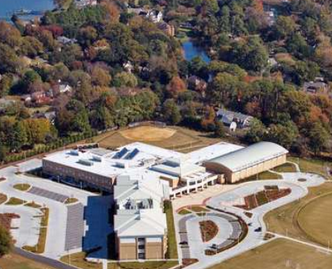 Some say climate change is too hard to teach to kids because it's so depressing...or too controversial...but here’s one school district that has turned that idea on its ear!
Some say climate change is too hard to teach to kids because it's so depressing...or too controversial...but here’s one school district that has turned that idea on its ear!
The Virginia Beach City Public Schools are a stellar example of what’s possible. Under the leadership of Sustainability Officer Tim Cole and with the support of administrators and faculty, the school buildings themselves—many of them LEED Gold or Platinum—provide the framework for all the sustainability initiatives in the district, which has conducted a detailed greenhouse gas inventory to establish a baseline and looked for ways of substantially reduce emissions.
The facilities, inside and out, are treasure troves of teachable moments, not only about energy conservation and efficiency, but about related issues, such as daylighting, which improves student performance; stormwater runoff and pollution; and, of course, sea level rise. (The city is only twelve feet above sea level, so the community is on the front lines of climate change.)
Cole, in a presentation about the district’s leading-edge efforts, describes how “[t]he myriad of sustainability strategies present in the school provides students with numerous opportunities to interact with environmental systems both in the planning phase and in the post-production operations and maintenance phase.”
So not only is it possible to teach about climate change without freaking out kids, it's possible to use climate change and related topics to introduce the very best science education practices, such as problem-based learning.
In a chapter in Marketing the Green School: Form, Function, and the Future titled "Enhancing Building Performance and Environmental Learning: A Case Study of Virginia Beach City Public Schools", Cole and co-author Shannon Chance of Hampton University share the goals that the district has been pursuing to provide the best possible learning—and living—environments:
• Integrating environmental issues throughout the curriculum
• Preparing students to bring new knowledge into the community and share it with their families and employers
• Introducing new construction techniques to the region
• Encouraging architects and builders to reach for higher standards
• Monitoring the division’s environmental performance and continually seeking improvements
• Disseminating their research and techniques for broad adoption
• Monitoring its own (and the community’s) energy and waste flows
• Striving to achieve net-zero carbon emission
Their case study highlights several important factors that districts wishing to follow Virginia Beach City's example will need to keep in mind. For example, setting a high bar is important because school buildings constructed today may be 200 year assets.
While the topic of climate change has been historically sensitive politically, being a major subplot in the recent Governor’s race, there have been no reports of substantial push-back on teaching climate change in the district.
Virginia’s existing science standards are lackluster in their coverage of climate change and currently the state has no plans to adopt the new Next Generation Science Standards, which do cover climate change and problem-solving skills.
Nevertheless, in talking with Virginia teachers at the National Science Teacher Association meeting in Richmond last month, it was clear that the new standards— and providing all students with the skills needed to meet the challenges of the 21st century—are being discussed and practiced by many Virginia science faculty.
And in Virginia Beach, because of the support and leadership at the district level, teachers have easily been able to weave climate, energy and related sustainability topics into the curriculum.
One fourth grade teacher in Virginia Beach teaches an interdisciplinary unit linking geography with weather, using interactive GIS maps to explore factors that affect climate. The topic of climate change has come up in the class even though it isn’t formally part of the curriculum, and some of the ten year olds have a pretty solid understanding and strong opinions about the topic.
The students develop a research question about climate change and factors that impact it, the teacher guides them to a few articles and then invites them to do their own research, and in short order they pull together a board full of notes and many more questions than they started with, questions that they will tackle in years to come, building on their foundational knowledge and inquiry.
Ideally, all 17,000 school districts in the U.S. could take the initiative as Virginia Beach has, physically and pedagogically transforming schools and by extension, their communities. As we’ve described before, there are other examples of schools that have taken the initiative at a grassroots level.
But the reality is that many districts, due to ideological or financial constraints, remain stuck firmly in the 20th century, with deteriorating, sometimes unhealthy infrastructure and old-school pedagogy, leaving students largely unprepared for the climate and energy challenges they will face. Districts like Virginia Beach are shining examples of what is possible and what we can all aspire toward.
